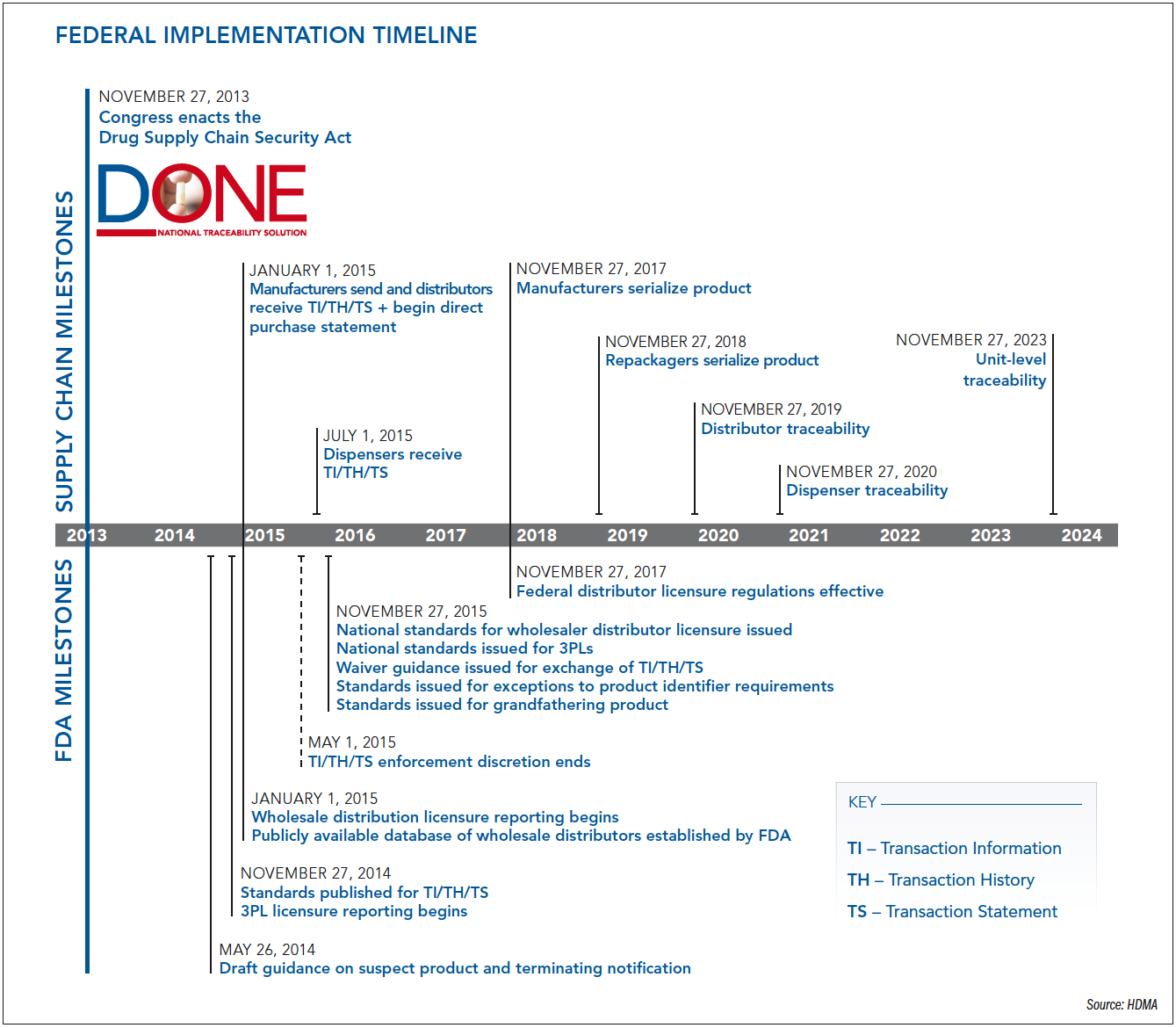Safeguarding the U.S. drug supply
The product-tracing deadline has been extended to November 1. Other requirements are on schedule. Here's what you have to do, and when you have to do it.
The Drug Supply Chain Security Act (DSCSA), known as Title II of the Drug Quality and Security Act, enacted in November 2013, promises to transform the way the U.S. supply chain operates by replacing a patchwork of pedigree requirements with an enhanced product-tracing solution for prescription drugs. It also raises licensure standards through the United States. The product-tracing requirements, assisted by FDA guidance, will be phased in over a 10-year period.
See also: Track-and-trace enforcement pushed back to November 1
Purpose of DSCSA
The intention of the legislation is to protect the U.S. supply chain from counterfeit, diverted, and stolen products. With passage and implementation of this act, which started this year, those involved in the supply chain are hopeful that patients treated in this country receive only legitimate prescription drugs that can be traced through the supply chain, starting with the manufacturer and subsequent trading partners, such as wholesale distributors, third-party logistics providers, repackagers, and pharmacies.
See also: FDA unveils new drug pedigree requirements
The DSCSA will help to prevent counterfeit products from entering the supply chain. While it is impossible to know the number of counterfeit drugs entering the supply chain, FDA has noted that counterfeit versions of Lipitor, Procrit, and Alli have been detected in the U.S. distribution system. According to the FDA website, although the number of counterfeit drugs that have entered the supply chain recently has not increased, it is important to take steps to prevent counterfeit drugs from reaching consumers.

Perry FriBesides counterfeit drugs, there is also the problem of diverted and stolen products.
“With the DSCSA, we are in a traceability environment where you can understand what lots or specific numbers of a product have been stolen and find ways to prevent them from re-entering the supply chain,” said Perry Fri, executive vice president of industry relations, membership, and education for HDMA, a national organization that represents primary pharmaceutical distributors in the United States.

Stacie MaassMembers of the American Pharmacists Association (APhA) are in favor of the new track-and-trace requirements, and APhA is helping its members with compliance, said Stacie Maass, APhA’s senior vice president, Pharmacy Practice and Government Affairs. “Our members are supportive of the changes to better help patients to receive safe and effective drugs and not have them be counterfeit,” Maass said.
AmerisourceBergen Corporation, a major pharmaceutical wholesaler that handles 35% of the U.S. pharmaceuticals, agrees that the implementation of the DSCSA will result in a safer supply chain for the entire healthcare industry.

Heather Zenk“For us, it is an important federal act to identify, manage, and treat products through the U.S. supply chain in a unified and standard way, vs. a patchwork quilt of requirements that we had in times past,” said Heather Zenk, vice president, Secure Supply Chain for AmerisourceBergen Corp. The wholesaler is working closely with its clients, including pharmacies, to ensure that they are able to meet the law’s track-and-trace requirements. (See side bar: “DSCSA: The wholesaler's role.”)
Implementation of DSCSA
Beginning January 1, 2015, manufacturers, wholesale distributors, and repackagers had to start complying with product-tracing requirements when a transaction of a prescription product took place and a change of ownership occurred between the trading partners, according to HDMA.
The product-tracing requirements included three specific transactions - transaction information (TI), transaction history (TH), and transaction statement (TS), which had to be captured and maintained for six years for each transaction.
- Transaction information must include the following: the name of the product, its strength and dosage form, NDC, container size, number of containers, lot number, transaction date, shipment date, and names and addresses of seller and buyer.
- Transaction history is a statement in paper or electronic form that includes the TI for every transaction, going all the way back to the manufacturer.
- Transaction statement is an attestation made by the trading partner who is transferring ownership. It confirms that it is an authorized entity and that it received the product from another authorized party; that it received TI, TH, and TS from the previous seller; and that it did not knowingly ship suspect or illegitimate product. The TI also confirms that the trading partner is able to perform verification of the product, did not knowingly provide false TI, and did not alter the TH.
Because many of those affected by the law needed additional time for compliance, FDA delayed enforcement of the product tracing requirement for manufacturers until May 1, 2015, so as not to impact patient access to prescription medications. However, the trading partners had to comply with the requirements to engage only with “authorized” trading partners, meaning those with a valid registration or state license. The trading partner also had to have established systems in place to handle suspect or illegitimate products, noted HDMA.
In July, dispensers - defined as a retail pharmacy, a hospital pharmacy, or a group of chain pharmacies under common ownership, as well as other authorized dispensers who administer prescription drugs - were also required to start receiving the TI, TH, and TS from their trading partners. This information had to be captured and stored for up to six years as well.
Pharmacies are allowed to contract with wholesale distributors or third-party vendors for the capture and storage of the three Ts (TI, TH, and TS). However, APhA has reminded pharmacies to review the contractual terms of any agreement for capture and storage of the three Ts, such as whether there are any costs associated with accessing the TI, TH, and TS, and whether charges are continued if the pharmacy is no longer a customer, said Maass.
“The act provides some exceptions [to supplying the required three Ts upon the transaction], if the prescription drug is sold directly to a patient or transferred to a pharmacy for a specific patient need,” Maass noted.

Not quite ready
Two weeks before the July 1, 2015, compliance date for pharmacies, the American Society of Health-System Pharmacists (ASHP) contacted FDA to request more time for hospital and health-system pharmacies to implement their data and storage processes. ASHP noted that the July deadline would be problematic for large health systems, which work with more than one drug supplier.
“Based upon input provided by hospital and health-system pharmacists, we believe that significant challenges remain for hospitals and health systems to fully comply with the new requirements by the July 1 deadline,” said Kasey Thompson, PharmD, vice president of ASHP’s Office of Policy, Planning and Communications, in a prepared statement.
The National Community Pharmacists Association (NCPA) also sent a letter in June to FDA, requesting more time for pharmacies to comply with the track-and-trace requirements. On behalf of NCPA, APhA, and the National Alliance of State Pharmacy Associations, NCPA said that feedback from the organizations’ members showed that more outreach and education was needed.

Doug Hoey“About half of the NCPA survey respondents [commenting before June 22] have been in contact with their wholesale distributors to discuss how the transaction information would be provided, and an almost equal number reported being unaware of services that wholesalers are offering to maintain and store the information. Less than 15% have entered into contractual arrangements with their wholesalers,” said B. Douglas Hoey, RPh, MBA, chief executive officer at NCPA, in a letter to Dr. Ilisa Bernstein, deputy director for FDA’s Office of Compliance.
FDA responded to the pharmacy organizations, giving pharmacies/dispensers an additional four months to comply with product-tracing requirements to ensure that product-tracing information is captured and maintained by the dispensers. The new deadline extends to November 1, 2015. (More information is available at the FDA website: http://bit.ly/dscsaINFO.)
In FDA’s compliance policy guidance, DSCSA Implementation: Product Tracing Requirements for Dispensers, manufacturers, wholesale distributors, and repackagers are still required to provide product-tracing information to pharmacies/dispensers. In addition, FDA requires that pharmacies/dispensers must provide subsequent owners with product-tracing information, including TH. If the pharmacy does not have the TH, the pharmacy needs to get it from the previous owner.
“FDA believes that product-tracing information serves as an important tool for dispensers [pharmacies] to meet their obligation to identify suspect product, quarantine the product, and investigate whether the product is illegitimate,” stated the FDA guidance.
FDA also would not delay the other requirements for dispensers, including verification related to suspect and illegitimate product, and engagement in transactions involving prescription products with “authorized” trading partners. Basically, every pharmacy should know whether its supplier is licensed and should know where the product is coming from.
Identification of suspect/illegitimate product
At the beginning of this year, FDA issued draft guidance (http://bit.ly/dscsaGUIDE), providing a definition for suspect/illegitimate product and a list of scenarios that should alert the pharmacy to increased risk of a suspect product entering the supply chain.
Some seem quite obvious, such as purchase of a product from a new source, receipt of an unsolicited sales offer from an unknown source, purchase of a product on the internet from an unknown source, or purchase of product from a source that the pharmacy knows has previously sold or delivered suspect or illegitimate product.
FDA also noted that there is increased risk of suspect product if the trading partner is reluctant to provide the TH or fails to provide the TH in a timely manner. Vigilance should also be practiced if the TI, TS, and/or TH are incomplete. A high demand for products or greater demand resulting from a public health emergency or other event, as well as a shortage of specific products, could also pose a threat to the supply chain.
Other signs mentioned by FDA that might indicate a suspect product include a low price that seems “too good to be true,” a compromised transport container or packaging, or a label on the package or individual retail unit that is missing information.
Pharmacies need to have in place a system or process they can use to inform their trading partners when they identify a suspect product. They also need a system or process to quarantine suspect product apart from their regular inventory, and a system or process they and their trading partners can use jointly to investigate and determine whether the suspect product is illegitimate.
The FDA draft guidance also requests that the trading partner and FDA be informed within 24 hours of determination that a product is illegitimate. APhA suggests that pharmacy staff be educated about the need to make these notifications and about the use of FDA Form 3911. (This form is available at http://bit.ly/dscsa3911.)
Upcoming deadlines
More deadlines are on the horizon as additional requirements of the DSCSA are implemented (see figure). The serialization timeline requires that specific stakeholders use a product identifier for each individual package. Starting in 2017, manufacturers will need to comply with this requirement, and then in 2018, compliance by repackagers will be required.
“The product identifier will include the standardized numerical identifier, lot number, and expiration date of the product. It will be a 2-D barcode, and it will be in human- and machine-readable form on every package. It is intended to be the smallest package that a manufacturer produces that will be sold to the pharmacies at the dispenser level,” said Gallenagh.
“It is important for pharmacies to be aware of the implementation schedule and have conversations with their wholesalers as the deadlines for specific DSCSA requirements occur,” she said.
DSCSA: The wholesaler's role
HDMA suggests that pharmacies work with their wholesaler(s), who already have front-end experience of receiving product from manufacturers.

Elizabeth Gallenagh“[Wholesalers] have been working - really for the last year and certainly from January 1, 2015 - on the interface between the manufacturers and the wholesalers. Now they are working on sending that information to the pharmacy customers,” said Elizabeth Gallenagh, senior vice president of government affairs and general counsel for HDMA.
AmerisourceBergen, with a distribution network that handles approximately 35% of the pharmaceuticals that are sold and distributed in the United States, has taken a significantly active role in education of its trading partners. According to Zenk, AmerisourceBergen offered its customers an informational series of webinars on six different occasions, for which more than 1,200 participants dialed in. The wholesaler also provided training for its customer base of pharmacies and pharmacists on how to access the new transactional datasets - TI, TH, TS - that must be passed between trading partners.
“We believe it is still a learning curve for a lot of the dispenser community, and they really want to understand how to access their data,” said Zenk. “For the most part, the dispensing and pharmacy community relies on us as their wholesaler to have their information and to store it for them. This is a real benefit that we feel we are bringing to the pharmacy-dispensing community.”
According to Zenk, pharmacies and dispensers can access their information through AmerisourceBergen’s e-commerce portal, known as Passport.
“This online ordering and e-commerce portal is where customers already have access. We have just added this information [transactional datasets of TI, TH, TS] to it.”
AmerisourceBergen is determined to make it as simple and easy as possible to access the three Ts. “We want this to be a seamless process, and we want them to have continuous access to pharmaceuticals, while also enhancing the supply chain,” Zenk said.
DSCSA: Additional resources
Here is a list of resources that can help with meeting the requirements set forth in the Drug Supply Chain Security Act.
FDA resources
Drug Supply Chain Security Act (text)
DSCSA Updates and Readiness Check: Requirements for Dispensers and other Trading Partners Webinar
HDMA resources
DSCSA Overview for Dispensers Webinar (audio and pdf available)
Dispenser Q&A for DSCSA Webinar (audio and pdf available)